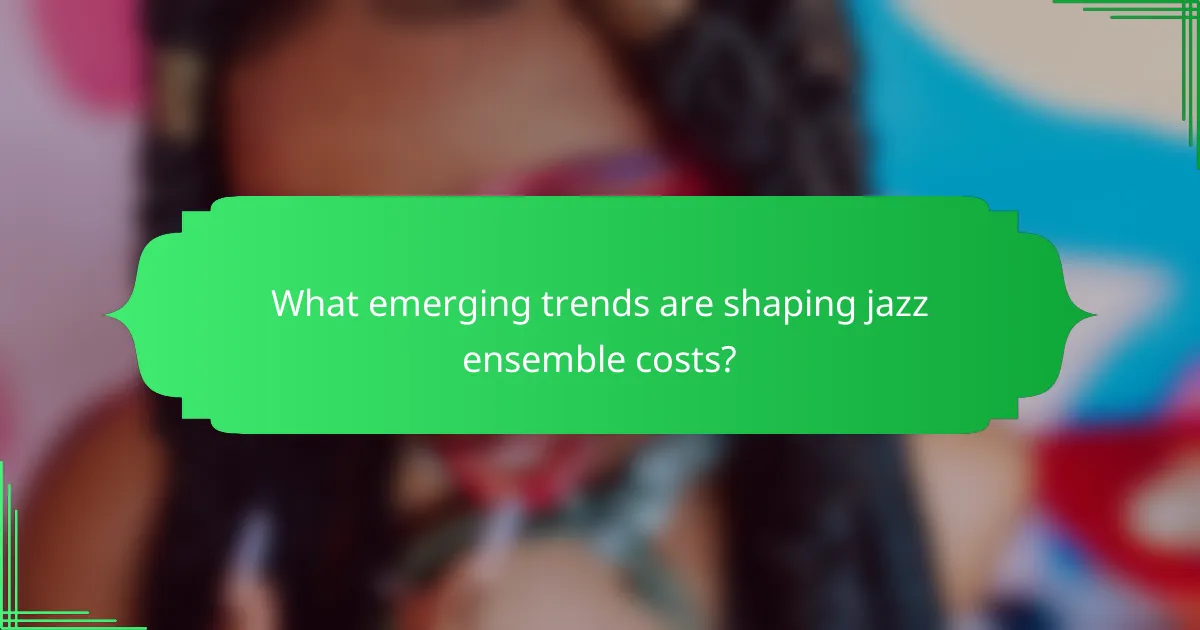Jazz ensembles face various financial considerations, including venue fees, equipment costs, and musician compensation. Venue fees in Canada can range from a few hundred to several thousand dollars, influenced by factors such as location and amenities. Additionally, equipment costs for instruments and sound gear can accumulate significantly, while musician compensation varies based on experience and venue specifics. Understanding these elements is crucial for successful financial planning in the jazz music scene.

What are the venue fees for jazz ensembles in Canada?
Venue fees for jazz ensembles in Canada can vary significantly based on location, size, and amenities. Generally, these costs range from a few hundred to several thousand Canadian dollars per event, depending on the venue’s prestige and services offered.
Average venue rental costs
The average rental cost for a venue suitable for jazz ensembles in Canada typically falls between CAD 500 and CAD 2,500. Smaller, local venues may charge lower fees, while larger or more prestigious locations can demand higher rates. It’s advisable to budget for additional costs such as sound equipment and staffing.
Factors affecting venue fees
Popular venues in Toronto
Comparison of venue fees across cities

What are the equipment costs for jazz ensembles?
The equipment costs for jazz ensembles can vary significantly based on the type of instruments and gear needed. Generally, these costs include the purchase or rental of instruments, amplifiers, and other sound equipment, which can add up to several thousand dollars depending on the ensemble’s size and needs.
Typical equipment needed
A jazz ensemble typically requires a range of instruments and equipment, including brass instruments (trumpets, trombones), woodwinds (saxophones), rhythm section instruments (piano, bass, drums), and sometimes guitars. Additionally, sound equipment such as microphones, amplifiers, and speakers may be necessary for live performances.
Each musician may also need accessories like stands, cables, and cases, which can contribute to overall costs. Ensuring that all members have access to quality instruments and equipment is crucial for achieving a professional sound.
Average costs of instruments
The average costs of instruments for a jazz ensemble can vary widely. For example, a good quality saxophone can range from around $1,000 to $3,000, while trumpets and trombones typically fall between $500 and $2,500. Pianos and electric keyboards can cost anywhere from $300 to over $5,000, depending on the brand and features.
In addition to the initial purchase price, consider ongoing maintenance costs, which can include repairs and regular tune-ups. Budgeting for these expenses is essential for long-term sustainability.
Rental vs. purchase costs
When deciding between renting and purchasing equipment, consider the frequency of use and budget constraints. Renting instruments can be a cost-effective solution for short-term needs, with prices often ranging from $30 to $100 per month per instrument.
However, purchasing may be more economical in the long run for ensembles that perform regularly. Weigh the pros and cons of each option, and factor in the potential depreciation of purchased instruments over time. If possible, try out rented equipment before committing to a purchase to ensure it meets your ensemble’s needs.

How is musician compensation structured?
Musician compensation in jazz ensembles typically varies based on factors like experience, venue, and location. Understanding the structure of pay rates, influencing factors, and payment models can help both musicians and venues navigate financial agreements effectively.
Standard pay rates for jazz musicians
Standard pay rates for jazz musicians can range widely, often falling between $100 to $500 per gig, depending on the musician’s experience and the venue’s prestige. Established musicians or those performing in high-demand locations may command higher fees, while emerging artists might earn lower rates.
In some cases, musicians may also receive additional compensation through tips or a share of the cover charge, which can supplement their base pay. It’s common for venues to negotiate rates based on the expected audience size and event type.
Factors influencing musician fees
Several factors influence musician fees, including the musician’s skill level, the complexity of the performance, and the duration of the gig. Experienced musicians with a strong reputation often have leverage to negotiate higher rates.
Location also plays a critical role; urban areas with vibrant music scenes typically offer higher compensation compared to rural settings. Additionally, the type of event—such as private parties, festivals, or club performances—can significantly impact pay rates.
Payment models (per gig vs. salary)
Musicians are commonly compensated on a per-gig basis, where they receive a set fee for each performance. This model allows for flexibility but can lead to income variability, especially for those who perform infrequently.
Alternatively, some musicians may secure salaried positions with bands or venues, providing a stable income. This model is less common in jazz but can offer benefits such as consistent pay and job security, making it appealing for those seeking long-term engagements.

What are the prerequisites for hiring a jazz ensemble?
Hiring a jazz ensemble requires understanding the necessary permits, licenses, and technical requirements for your venue. Ensuring compliance with local regulations and providing the right equipment will facilitate a smooth performance.
Required permits and licenses
Before hiring a jazz ensemble, check if you need specific permits or licenses to host live music events. Many local jurisdictions require a performance license, especially if the venue serves alcohol or has a capacity exceeding a certain number of attendees.
Contact your local government or licensing authority to determine the exact requirements. In some cases, you may also need to secure a copyright license if the ensemble plays copyrighted material.
Technical requirements for venues
Venues must meet certain technical specifications to accommodate a jazz ensemble effectively. This includes adequate space for the musicians, proper sound equipment, and sufficient power supply for instruments and amplifiers.
Consider the layout of your venue; a stage or raised area can enhance visibility and acoustics. Additionally, ensure that the sound system can handle live performances, which may involve renting or purchasing microphones, speakers, and mixing equipment.

How do venue fees compare to other music genres?
Venue fees for jazz ensembles typically fall within a moderate range compared to other music genres, reflecting both the unique appeal of jazz and its audience. While fees can vary significantly based on location and venue size, they often align closely with classical music venues but differ from rock music venues, which may command higher rates due to larger crowds and more extensive production requirements.
Comparison with classical music venues
Jazz venues often share similarities with classical music venues in terms of ambiance and audience size, leading to comparable fee structures. For instance, both genres may charge between $500 to $2,000 for an evening performance, depending on the venue’s prestige and location. However, classical venues may have additional costs related to orchestral arrangements and formal settings.
Additionally, classical music venues might require more extensive technical setups, which can increase overall expenses. Jazz ensembles, on the other hand, may have lower equipment costs, allowing for more flexibility in budget allocation.
Comparison with rock music venues
In contrast, rock music venues typically have higher venue fees, often ranging from $1,000 to $5,000 or more, due to larger audience capacities and the need for extensive sound and lighting equipment. This difference can be attributed to the more substantial production demands and the potential for higher ticket sales in rock performances.
Jazz performances, while they can attract dedicated audiences, generally operate in smaller venues, which can lead to lower overall costs. However, jazz musicians may still face competition for prime slots in popular venues, which can influence negotiation strategies for fees.

What emerging trends are shaping jazz ensemble costs?
Emerging trends in jazz ensemble costs are influenced by venue fees, equipment expenses, and musician compensation. As the live music scene evolves, these factors are increasingly affected by market demand, technology, and changes in audience preferences.
Venue Fees
Venue fees for jazz ensembles can vary widely based on location, size, and popularity. Smaller venues may charge a few hundred dollars, while larger or more prestigious locations can demand thousands. It’s essential to research local venues and understand their pricing structures to budget effectively.
Consider negotiating with venues, especially if you can guarantee a certain number of ticket sales. Some venues may offer lower fees in exchange for a share of the ticket revenue, which can be beneficial for both parties.
Equipment Costs
The costs of equipment for jazz ensembles can range from basic to professional-grade setups. Essential items like instruments, amplifiers, and sound systems can total anywhere from a few hundred to several thousand dollars. Renting equipment is often a cost-effective option for smaller ensembles or one-time events.
When budgeting for equipment, consider both initial purchase costs and ongoing maintenance. Investing in quality gear can lead to better sound and fewer repairs, ultimately saving money in the long run.
Musician Compensation
Musician compensation varies based on experience, location, and the ensemble’s budget. Rates can range from low tens of dollars per hour for less experienced musicians to several hundred dollars for seasoned professionals. It’s crucial to establish clear payment terms upfront to avoid misunderstandings.
Consider offering a flat fee per gig or a percentage of ticket sales, depending on the ensemble’s financial situation. Be transparent about how compensation is structured to foster trust and encourage long-term collaborations with musicians.
